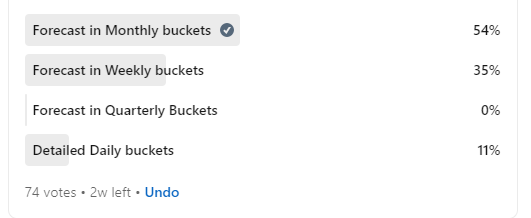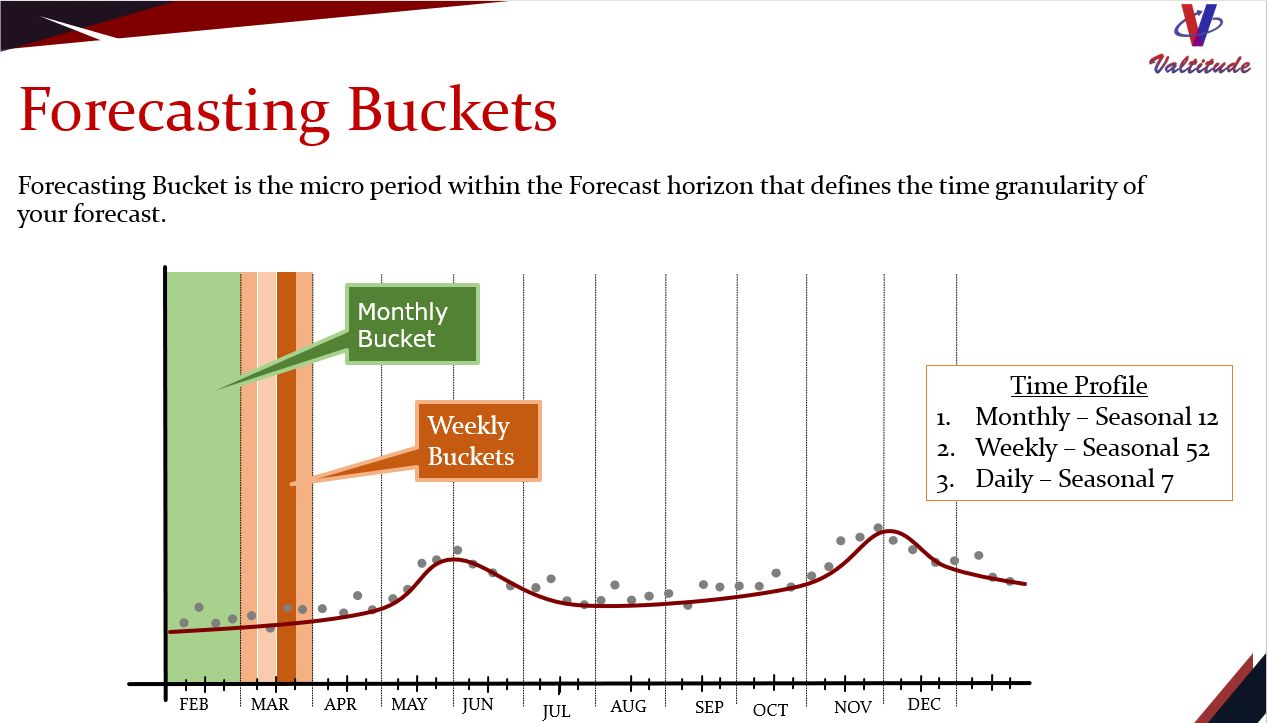What is the ideal forecasting (Time) bucket or micro-period?
When it comes to dealing with time periods in forecasting, the periodicity or frequency of the forecasting cycle is one consideration, and the time buckets are another consideration.
The forecasting time bucket is the micro-period that carries the forecast and expresses the calendar granularity in your forecasts. Most demand forecasts for revenue planning and S&OP are in monthly buckets. Forecasts conveyed to the supply chain are also typically done in monthly buckets but often translated into weekly buckets.
The calendar conversion could also be a source of error in demand forecasts for supply chain planning.
What is the ideal forecasting time bucket? One of our client managers was asking about a quarterly time bucket! But the tactical planner was thinking about how to plan in daily buckets for their detailed schedule.
What is your ideal time bucket?
Monthly - Demand and Revenue Planning
Weekly - Supply Planning. Will you translate or develop an independent plan?
Daily?
How about Quarterly buckets? Will this be the norm when you are developing the strategic forecast for the next ten years at a high level?
We had posted this on Linked-in and received a variety of comments. These are summarized here.
The weekly and monthly buckets are equally helpful and considerable while forecasting. While the usage of daily buckets can decrease the chance of having errors in the fiscal calendar, weekly and monthly buckets are mainly used for supply chain and tactical forecasts.
There are many views that can be considered while taking sides in this discussion of choosing weekly/monthly/daily/quarterly buckets.
Anirban Roy Chowdhury of Landis+Gyr, India feels that the choice of bucket depends on the type of product. In his own words:
" The choice of bucket that can be used for forecasting depends on the type of products that are considered, either off-the shelf or customized. Lead time has been increasing in these unprecedented times in the case of customized products, further making weekly/monthly bucket forecasting invalid. For visible orders and longer timeframes, the ideal bucket/forecasting techniques that may be useful are quarterly and rolling forecasts, respectively.”
Likewise, Lynley Blow from Mars, Australia also feels that the need for daily planning would be dependent on the types of products. In her own words:
“The need for daily planning would be dependent on the types of products you are manufacturing. There are also factors within Supply Planning that can be important, eg. daily actual inventory, but all these factors depend on the cadence of your process. For S&OP reporting aggregate the weeks into the necessary time bucket (period or quarter) depending on the horizon of the analysis.”
There are many thoughts of line that can be considered. Jeff Harrop of Ontario, Canada mentions the usage of automated forecasts.
“The weekly forecasting cycle is the heartbeat of the retail business (weekly numbers transforming into daily traffic numbers to schedule the supply chain to respond.). New highly automated forecasting approaches that thrive on elevated levels of granularity offer the promise of a daily forecasting cycle that can find even more discrete patterns. Although, there is an absence of these approaches being implemented in cases where a sizable percentage of time series are intermittent, these can help to gain traction and demonstrate the ability to separate signal from noise with these challenging demand streams and produce results that are sensible and easily understood by demand planners.”
Weekly and monthly buckets can be equally useful in forecasting, as Clark Hochradel of The Scotts Miracle-Gro Company, North Carolina Area mentioned:
“Weekly and monthly buckets can both be equally useful in forecasting. In specific, weekly bucket enables breaking the forecasts out to different customer calendars.”
Periyasamy R of ABB, India feels that inbuilt flexibility plays a very crucial role in forecasting.
In his own words, “Weekly bucket can be a great pick, provided there is the right percentage of inbuilt flexibility to accommodate the changing scenarios. Generally, no planning timeframe is effective without inbuilt flexibility.”
Pete Rakytaik of Wipro Limited, Ohio, United States says, “In an industry like F&B where demand planning is driving production, weekly demand planning and daily forecast consumption would be recommended.”
Cyrille Toffa of Sanofi, Lyon, Auvergne-Rhône-Alpes, France feels that "bucket choice is business dependent.
To quote the words, “The bucket choice depends on the business specificities. For instance, daily bucket is a necessity in the dairy industry. Buckets can be by the hour for other businesses.”
Our linked-In POLL found the following:

It can be inferred from most of the comments and the poll that forecasts in monthly buckets and weekly buckets are the most popular choices amongst demand planners. 54% of the total responses favored monthly as the ideal time bucket followed by forecasts in weekly buckets which scored 35% of the votes, leaving detailed daily buckets with 11% and 0% votes for forecasts in quarterly buckets.
You can find the original linked in-post here:
https://www.linkedin.com/feed/update/urn:li:activity:6885375265409769472


Leave a Reply